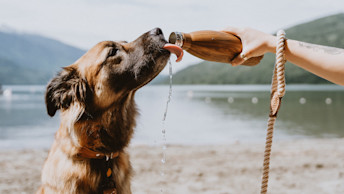June 27, 2024
Dehydration in Dogs: Keeping Your Pup Hydrated

As pet parents, we've all been there, the sweltering summer heat hits, and our furry friends start panting up a storm. It's a scene that can quickly turn concerning if we're not careful about keeping them hydrated. Dehydration in dogs is no joke, it can lead to some ruff consequences if left unchecked. But don't worry, we've got your back (and your pup's!).
In this guide, we'll dive into everything you need to know about dehydration, from the telltale signs to simple steps to keep your pooch properly hydrated.
What Causes Dehydration in Dogs?
Dehydration happens when your dog's fluids get low. It can be due to not drinking enough water, losing liquids through vomiting or diarrhea, or simply panting more in the summer heat. Certain medical conditions like kidney disease can also make dogs more prone to dehydration.
Essentially, when fluid loss exceeds fluid intake, your pup's body doesn't have enough water and electrolytes to keep operating at peak zoomie levels4. And even mild dehydration can take a toll if it goes untreated.

Signs of Dehydration in Dogs
Dehydration can sometimes be tricky to spot, but there are some key signs that indicate your pup is running a little dry:
Lethargy and weakness1,3: Dehydrated dogs have less energy and may appear more tired and sleepy. They may move around less and seem unwilling to go for walks or play.
Dry mouth and gums1,2,3: One of the clearest signs is dry or sticky gums and mouth. Gently pull up your dog's lips and check that their gums look moist and pink, not dry or tacky.
Sunken eyes1,3: As dogs become dehydrated, the soft tissue around their eyes may appear sunken. Their eyes may seem like they are sitting deeper in their sockets.
Loss of skin elasticity1,2,3: Gently pinch and release the skin along your dog's back. If they are well hydrated, the skin should snap back immediately. Dehydrated skin will "tent" and take longer to return to normal.
Dry nose1,3: Dogs normally have wet, cool noses. A warm, dry nose can signal dehydration.
Panting excessively3: Dogs pant to cool themselves, but excessive panting for no reason can indicate dehydration.
Urinating less frequently2: Well hydrated dogs will need to urinate regularly. Dehydrated dogs may go longer without needing to pee.
Vomiting1,2: Throwing up fluid and being unable to replace it can lead to dehydration.
Diarrhea1,2: Loose stools cause fluid loss, which can result in dehydration if not replaced.
If you notice a combo of these signs, it's time to give your vet a call. Mild dehydration can escalate quickly, so it's better to get ahead of it.

Preventing Dehydration in Dogs
The good news? Helping prevent dehydration is simple if you know what to do. Here are some hydration hacks for the summer:
Make sure your dog always has access to fresh, clean water. Make water easily available both indoors and outdoors. Check the water bowl frequently to refill it as needed. Consider getting a drinking fountain if your dog prefers moving water.
Limit time spent outdoors during hot weather. Take walks early or late in the day when temperatures are cooler. Avoid strenuous exercise when it's hot and humid. Watch for signs of overheating.
Monitor activity levels. Dogs that exercise heavily like working dogs or dogs that love to run and play hard should take more frequent water breaks. Adjust activity on extremely hot days.
Traveling can increase dehydration risk if not properly monitored. Bring plenty of water for car rides and outdoor adventures. Take a collapsible bowl and bottled water.
Pay attention to health issues. Dogs that are sick, old, or take certain medications may become dehydrated more easily. Discuss hydration needs with your veterinarian.
Choose a high-quality diet with adequate moisture. Wet food or adding water to kibble can help increase fluid intake.
Taking simple preventive steps can help keep dogs hydrated and healthy all year round. Be especially vigilant about access to water and activity levels during hot summer weather. Recognizing early signs of dehydration allows for prompt treatment.
In Conclusion
Dehydration is no fun for anyone, whether you're a pet or their parent. But by knowing the causes, spotting the signs early, and taking preventive steps, you can keep your pup well-hydrated and feeling their best all season long.
Diener, Michelle, DVM. "Dog Dehydration: How to Recognize It and What to Do." Veterinary Emergency Group. Accessed May 24, 2024. https://veterinaryemergencygroup.com/blog/dog-dehydration/.
Elliott, Pippa, MRCVS, and WikiHow Contributors. "How to Determine if a Dog Is Dehydrated." WikiHow. Accessed May 24, 2024. https://www.wikihow.com/Determine-if-a-Dog-Is-Dehydrated.
Gascoyne, Alexander, DVM. "Is My Dog Dehydrated?" PetMD. Accessed May 24, 2024. https://www.petmd.com/dog/symptoms/is-my-dog-dehydrated.
"Warning Signs of Dehydration in Dogs." American Kennel Club. Accessed May 24, 2024. https://www.akc.org/expert-advice/health/warning-signs-dehydration-dogs/.


